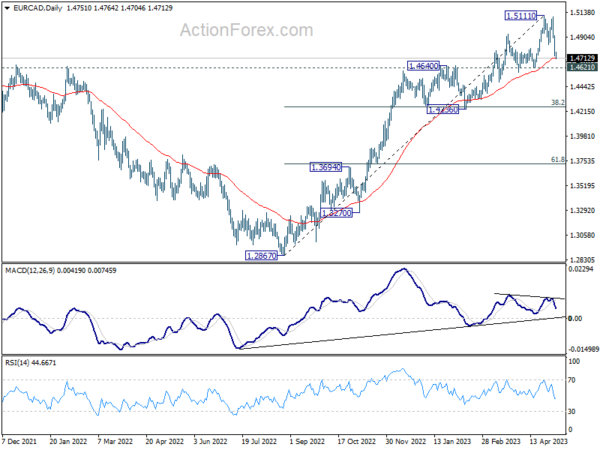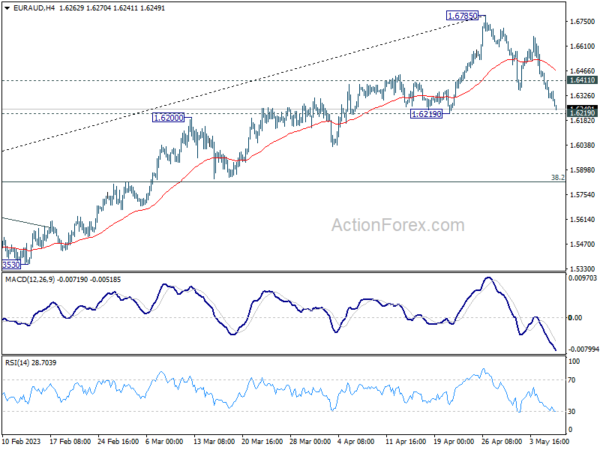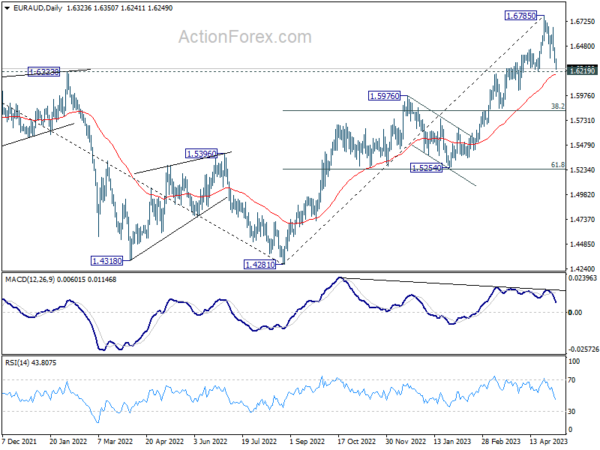Eurn turns weaker today after investor confidence data suggests that economic recovery might be faltering. But for now, Yen and Dollar are even weaker. Sterling and Swiss Franc are not much better than Euro too. Commodity currencies are the stars of the day, with New Zealand Dollar leading the way. Canadian Dollar is also catching up quickly, following Australian Dollar. Overall, the movement in currencies for the rest of the day will very much depend on development in risk sentiment.
Technically, one immediate focus now is whether EUR/AUD’s selloff would accelerate from current level. Sustained break of 1.6219 support, which is close to 55 D EMA (now at 1.6191) would argue that it’s already in correction to whole up trend from 1.4281. Deeper fall would be seen to 1.5254/5976 support zone. At the same time, break of 1.4621 support in EUR/CAD would align the outlook and bring deeper decline to 1.4235 support.
In Europe, UK is on holiday. At the time of writing, DAX is up 0.21%. CAC is up 0.30%. Germany 10-year yield is up 0.0354 at 2.330. Earlier in Asia, Nikkei dropped -0.71%. Hong Kong HSI rose 1.24%. China Shanghai SSE rose 1.81%. Singapore Strait Times dropped -0.27%. Japan 10-year JGB yield dropped -0.0107 to 0.413.
Eurozone Sentix hits lowest level since January, recovery beginning to falter
Eurozone Sentix Investor Confidence fell to its lowest level since January, dropping from -8.7 to -13.1 in May. Current Situation Index slipped from -4.3 to -7.0, while Expectations Index declined from -13.0 to -19.0 – its lowest point since December 2022.
Sentix commented, “The spring upswing in individual eurozone countries has so far been subdued anyway. Now the eurozone economy is being gripped by significant spring fatigue.” The organization added that although the Eurozone economy weathered the winter months better than many had feared, energy shortages remain a perennial issue. High inflation data continues to hamper consumer spending, causing the economic recovery to falter.
Regarding inflation, Sentix noted, “the Inflation Barometer does not indicate any sustained easing, which should give the central banks little leeway to deviate from their restrictive path in their current key interest rate policy.”
Japan’s PMI services reaches record high in April, record optimism too
Japan PMI Services rose to 55.4 in April, up from 55.0 in March, marking the eighth consecutive month in growth territory. This represents the highest reading since records began in 2007, surpassing the previous record set in 2013. S&P Global also noted that year-ahead business expectations reached an all-time high, while prices charged increased at the steepest pace in nine years. Meanwhile, the PMI Composite remained unchanged at 52.9, as stronger services growth offset a sharper reduction in manufacturing production.
Tim Moore, Economics Director at S&P Global Market Intelligence attributed the record rise in service sector output to a rebound in demand for face-to-face consumer services, recovery in international tourist arrivals, and improvement in new business from abroad.
Moore also emphasized the high level of business confidence, with around four times as many service providers expecting an increase in activity as those forecasting a decline. This optimism marked the highest level in more than 15 years of data collection.
Furthermore, service providers increasingly passed on higher business expenses to customers to alleviate pressure on margins from rising wages and transportation costs. This resulted in the steepest increase in service sector output charges since the sales tax hike in April 2014.
BoJ minutes: Few members saw positive signs towards price target
Minutes of BoJ’s meeting on March 9 and 10 show a continued commitment to monetary easing, with the aim of achieving price stability in a sustainable and stable manner, accompanied by wage increases. Nevertheless, a few members noted emerging “positive signs” toward reaching the price stability target, indicating a changing price environment.
With respect to yield curve control, some members emphasized the need to examine the effects of various implemented measures aimed at improving market functioning. They acknowledged that JGB yield curve appeared smoother than before. One member explained that if observed CPI inflation declined and market projections of interest rates calmed down, distortions in the yield curve would likely be corrected.
In terms of the 2% price stability target, several members underscored the importance of maintaining its commitment. One member added that the central bank should anchor inflation expectations to 2% by committing to achieve the target.
Meanwhile, another member expressed concern that discussing the target might lead to “unnecessary speculation” on monetary policy conduct, especially given the growing possibility of achieving the price stability target. This member also argued against revising the joint statement of the government and BoJ.
Australia NAB business confidence rose to 9, conditions down to 14
Australia NAB Business Confidence index rose from -1 to 0 in April, while Business Conditions slipped from 16 to 14. A closer look at the details reveals that trading conditions declined from 24 to 20, profitability conditions dropped from 13 to 11, and employment conditions edged up from 10 to 11.
Price and cost growth indicators were mixed, with labor cost growth holding steady at 1.9% in quarterly equivalent terms, and purchase cost growth increasing to 2.3% (up from 1.9% in March). However, overall price growth was 1.1% (down from 1.3%), and inflation in the retail sector declined to 1.4% (down from 1.7%).
NAB Chief Economist Alan Oster pointed out that business conditions, although lower, remained well above their long-run average. Confidence, although still below average, has stabilized around 0 index points in recent months. Furthermore, Oster observed some easing in price measures this month, even as cost pressures remained high. This trend may signal a gradual easing of inflation in Q2’s early stages, though inflation remains elevated.
EUR/AUD Mid-Day Outlook
Daily Pivots: (S1) 1.6266; (P) 1.6365; (R1) 1.6416; More…
Immediate focus is now on 1.6219 support tin EUR/AUD. Considering bearish divergence condition in D MACD, decisive break of 1.6219 will argue that it’s already in correction to whole up trend from 1.4281. Deeper decline would then be seen to 38.2% retracement of 1.4281 to 1.6785 at 1.5282, which is inside 1.5254/5976 support zone. On the upside, break of 1.6411 minor resistance will retain near term bullishness and turn bias back to the upside for retesting 1.6785 high.
In the bigger picture, the solid break of 1.6434 resistance argues that whole down trend from 1.9799 (2020 high) has completed at 1.4281 (2022 low). Further rise should be seen to 61.8% retracement of 1.9799 to 1.4281 at 1.7691 next. For now, outlook will stay bullish as long as 1.5976 resistance turned support holds, even in case of deep pull back.
Economic Indicators Update
| GMT | Ccy | Events | Actual | Forecast | Previous | Revised |
|---|---|---|---|---|---|---|
| 23:50 | JPY | BoJ Meeting Minutes | ||||
| 01:30 | AUD | NAB Business Conditions Apr | 14 | 16 | ||
| 01:30 | AUD | NAB Business Confidence Apr | 0 | -1 | ||
| 01:30 | AUD | Building Permits M/M Mar | -0.10% | 3.00% | 4.00% | |
| 06:00 | EUR | Germany Industrial Production M/M Mar | -3.40% | -1.60% | 2.00% | 2.10% |
| 08:30 | EUR | Eurozone Sentix Investor Confidence May | -13.1 | -7.9 | -8.7 | |
| 14:00 | USD | Wholesale Inventories Mar F | 0.10% | 0.10% |















